The Abu Simbel Temple, nestled along the Nile River in Aswan, Egypt, stands as a testament to the architectural prowess of ancient Egyptian civilization. This mammoth rock-cut temple complex, dedicated to Pharaoh Ramses II and the goddess Hathor, captivates visitors with its colossal statues and intricate carvings. While the journey to this remote site may require some planning, the opportunity to witness the grandeur of this UNESCO World Heritage location is undoubtedly worthwhile. As one delves deeper into the history and significance of Abu Simbel, the true wonder of this magnificent ancient wonder becomes increasingly apparent.
Key Points
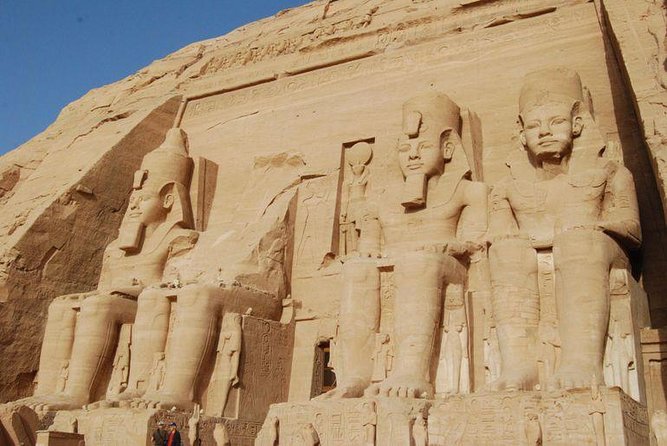
- Abu Simbel is a temple complex in Aswan, Egypt, consisting of two massive rock-cut temples built during the reign of Pharaoh Ramses II over 3,000 years ago.
- The larger temple is dedicated to Ramses II, while the smaller one is dedicated to the goddess Hathor and Ramses II’s wife, Queen Nefertari.
- The temple complex is famous for its colossal statues of Ramses II, each standing 65 feet tall, and is considered one of the most impressive and well-preserved ancient Egyptian sites.
- Visitors can reach Abu Simbel from Aswan (3-hour drive), Luxor (4-hour drive), or Cairo (8-hour drive), with guided tours offering door-to-door transportation and a private guide.
- The temple complex offers a glimpse into ancient Egyptian history and the engineering feats of the era, with intricate carvings, stunning architectural features, and a precise alignment with the sun’s position during the winter solstice.
Overview of Abu Simbel Temple
The Abu Simbel temple complex consists of two massive rock-cut temples built over 3,000 years ago during the reign of Pharaoh Ramses II.
The larger of the two temples is dedicated to Ramses II, while the smaller one is dedicated to the goddess Hathor and Ramses II’s beloved wife, Queen Nefertari.
The temples are famous for their colossal statues of Ramses II, which stand at the entrance of the main temple.
The complex is considered one of the most impressive and well-preserved ancient Egyptian sites, with its intricate carvings and stunning architectural features.
Visitors to the Abu Simbel temple can marvel at the sheer scale and grandeur of this remarkable ancient wonder.
You can also read our reviews of more tours and experiences in Aswan.
Getting to Abu Simbel Temple
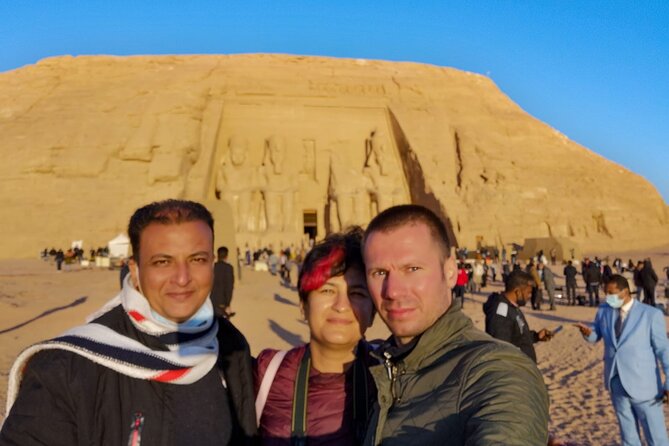
Reaching the Abu Simbel temple can be challenging due to its remote location in southern Egypt, but a guided tour can make the journey more seamless for visitors. This full-day excursion from Aswan includes door-to-door transportation, an air-conditioned vehicle, and a private guide to provide insights along the way. The tour is limited to a maximum of 15 travelers, ensuring an intimate experience.
| Getting to Abu Simbel | Time | Distance |
|---|---|---|
| From Aswan | 3 hours | 290 km |
| From Luxor | 4 hours | 390 km |
| From Cairo | 8 hours | 850 km |
The tour includes entrance fees, air-conditioned transportation, and a professional guide, making it an accessible and hassle-free way to visit this remarkable ancient site.
Highlights of the Temple Complex
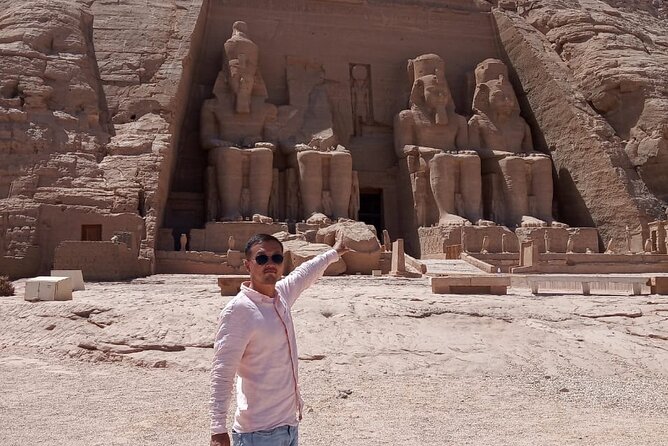
Visitors regularly marvel at the sheer scale and grandeur of the Abu Simbel temple complex, which features two massive rock-cut temples dedicated to Pharaoh Ramses II and his queen, Nefertari.
The larger of the two temples is dominated by four statues of Ramses II, each standing 65 feet tall. Inside, visitors can explore the elaborate interior, including hypostyle halls, shrines, and chambers adorned with intricate hieroglyphic carvings and wall paintings.
The smaller temple, dedicated to Nefertari, is equally impressive, with six statues of the queen standing alongside those of Ramses II.
Exploring these awe-inspiring monuments offers a glimpse into ancient Egyptian history and the engineering feats of the era.
Architectural Significance of Abu Simbel
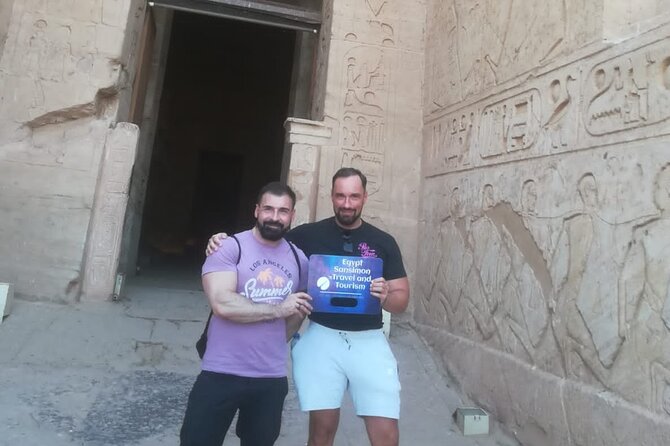
Abu Simbel’s architectural significance lies in its remarkable feat of engineering, as the entire temple complex was meticulously carved out of a single mountainside. Pharaoh Ramses II commissioned this colossal project, which features massive statues of himself and his queen, Nefertari, that stand as a testament to the Egyptian civilization’s extraordinary capabilities during the New Kingdom period.
| Architectural Features | Significance | Technical Achievements |
|---|---|---|
| Massive rock-cut temples | Demonstrates the scale and ambition of ancient Egyptian construction | Precise planning and execution to carve the temples out of solid rock |
| Towering statues of Ramses II and Nefertari | Symbolize the pharaoh’s power and the importance of the royal couple | Intricate sculpting and placement of the statues within the temple complex |
| Alignment with the sun’s position | Allows for dramatic lighting effects during the winter solstice | Precise astronomical calculations and engineering to align the temples |
Exploring the Colossal Statues
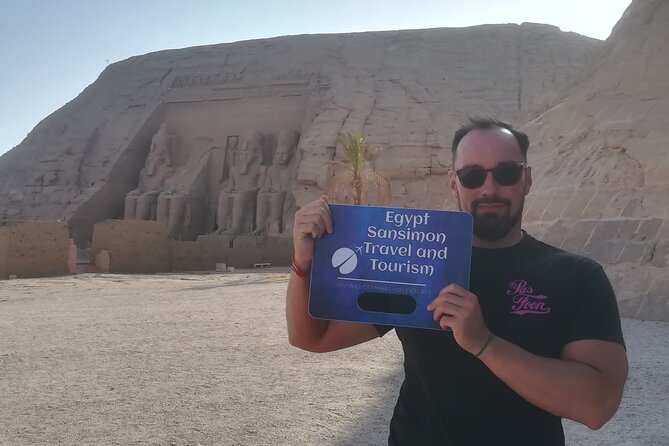
The colossal statues of Ramses II and Nefertari stand as the centerpiece of the Abu Simbel temple complex, their towering presence commanding the attention of all who behold them.
Each statue measures an impressive 69 feet in height, carved from a single piece of quarried rock.
The sheer scale of these monumental figures is awe-inspiring, showcasing the incredible engineering feats of ancient Egypt.
Visitors can marvel at the intricate details carved into the pharaoh and queen’s faces and bodies, a testament to the skill of the craftsmen who created them.
The colossal statues are a must-see for any traveler visiting the Abu Simbel temple, offering a humbling glimpse into the grandeur of Egypt’s past.
- Private Day Tour to Abu Simbel Temples From Aswan
- Abusimbel& 3 Nights Nile Cruise
- 4-Days 3-Nights Cruise From Aswan to Luxor Including Abu Simbel Hot Air Balloon
- 4-Day 3-Night Nile Cruise From Aswan to Luxor – Private Tour
- Full Day Tour to Abu Simbel Temples From Aswan
- 6 Days Nile Cruise:Luxor,Aswan,Abu Simbel With Train Tickets From Cairo
History and Cultural Significance
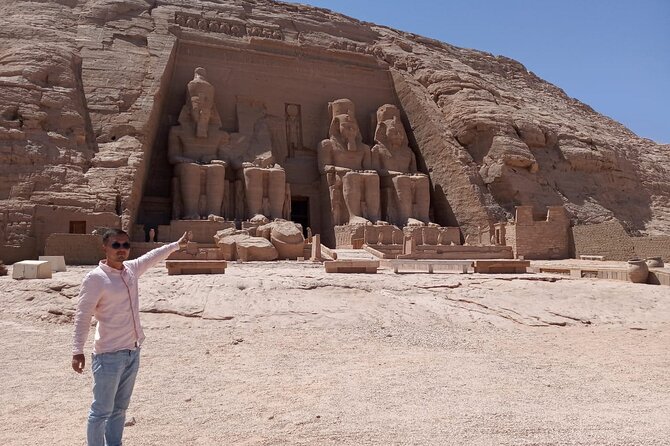
The Abu Simbel temple complex dates back to the reign of Pharaoh Ramses II in the 13th century BCE, showcasing the immense power and grandeur of ancient Egyptian civilization. This colossal temple was dedicated to the gods Ra and Amun and featured four massive statues of Ramses II, each standing 65 feet tall.
The temple complex was meticulously carved into a mountainside and is considered an engineering marvel of the ancient world.
In the 1960s, the entire complex was relocated to higher ground to avoid being submerged by the construction of the Aswan High Dam, a testament to the cultural significance of this iconic site.
Visitors can explore the intricate hieroglyphic carvings and murals that depict the life and achievements of Ramses II, providing a glimpse into Egypt’s rich history.
The Abu Simbel temple complex remains one of the most awe-inspiring and well-preserved examples of ancient Egyptian architecture and a must-visit destination for anyone exploring Aswan.
Tour Inclusions and Accessibility
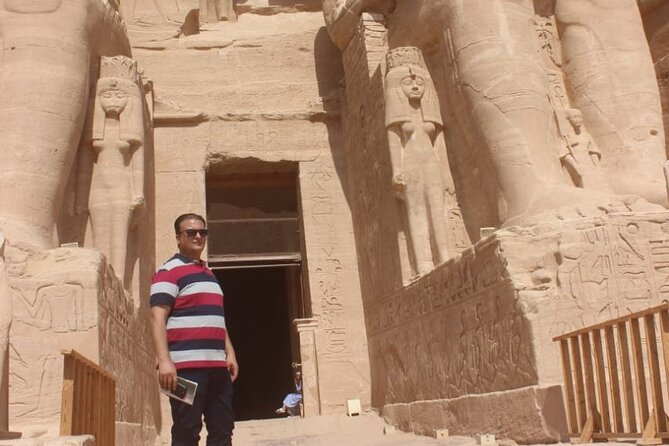
This full-day, small-group excursion from Aswan provides travelers with door-to-door hotel transfers, air-conditioned vehicle transportation, and a private guide who offers insights and context.
The tour is limited to a maximum of 15 travelers, creating an intimate experience. Pickup and drop-off can be arranged from anywhere in Aswan or at a designated meeting point.
The tour includes entrance fees, ensuring a hassle-free experience. The temple complex is wheelchair and stroller accessible, making it a suitable option for a wide range of travelers.
Confirmation is provided at the time of booking, and free cancellation is available up to 24 hours before the experience starts, providing flexibility for travelers.
Booking and Cancellation Policy
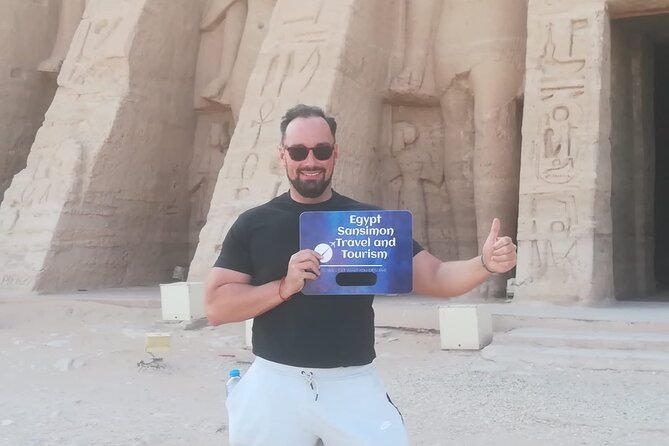
Confirmation is provided at the time of booking, and travelers can take advantage of free cancellation up to 24 hours before the experience starts, offering them flexibility in their plans.
This tour is designed to provide a hassle-free experience, allowing visitors to focus on the excitement of exploring the Abu Simbel temple.
Confirmation is provided immediately upon booking, ensuring travelers have peace of mind.
Free cancellation is available up to 24 hours before the tour, accommodating last-minute changes in plans.
This flexible policy empowers travelers to book with confidence, knowing they can adjust their itinerary if needed.
The streamlined booking process and generous cancellation terms make planning this tour a breeze.
Frequently Asked Questions
What Are the Best Times to Visit Abu Simbel Temple?
The best times to visit Abu Simbel Temple are early morning or late afternoon when the crowds are smaller and the lighting’s more favorable. Avoid the midday heat and crowds by planning an early or late visit.
Can I Take Photographs Inside the Temple Complex?
Yes, visitors can take photographs inside the Abu Simbel temple complex. Photography is allowed throughout the site, providing a great opportunity to capture the impressive carved rock temples and ancient Egyptian artwork.
Are There Any Dress Code Requirements for Visiting the Site?
There are no strict dress code requirements for visiting the Abu Simbel temple site. However, visitors are advised to dress modestly, covering their shoulders and legs, to respect the cultural and religious significance of the site.
Are There Any Restaurants or Facilities Available On-Site?
There are a few basic facilities on-site, including a small visitor center with a cafeteria and restrooms. However, there are no full-service restaurants at the Abu Simbel temple complex. Visitors should plan to bring their own food and water.
How Long Should I Plan to Spend at the Abu Simbel Temple?
Visitors typically spend 1-2 hours exploring the Abu Simbel temple complex. This allows time to marvel at the impressive carved statues, learn about the site’s history, and visit both the Great Temple and the Temple of Hathor.
Recap
Abu Simbel Temple is a must-visit destination for those exploring ancient Egyptian history.
The colossal statues and intricate architecture showcase the engineering prowess of the era.
Visitors can easily access the site and join comprehensive tours to fully enjoy the temple’s cultural and historical significance.
With proper planning, travelers can make the most of their experience at this iconic UNESCO World Heritage Site.
More Tour Reviews in Aswan
- Aswan Airport Arrival Transfer
- 3 Night Nile Cruise Aswan Luxor From Aswan With Abu Simbel
- Day Tour To Nubian Museum And Temple Of Isis In Aswan
- 2 Night Sailing Nile Cruise Including Highlights Tours In Luxor From Aswan
- 4-Days Nile Cruise Tour From Aswan to Luxor and Hot Air Balloon on M/S Le Fayan
- Aswan Botanical Garden & Private Felucca Tour
Not for you? Here's more things to do in Aswan we have recnetly reviewed
- 20 Best 4 Day Tours In Aswan
- 3 Best 2 Day Tours In Aswan
- 4 Best 3 Day Tours In Aswan
- 2 Best Full-Day Tours In Aswan
- 25 Best Cruises And Boat Tours In Aswan
- Private Trip to the Nubian Village by Motorboat in Aswan
- Abu Simbel From Aswan Include Entrance Fees
- Abu Simbel Day Trip From From Aswan
- Abu Simbel by Car
- 3-Nights Cruise Aswan to Luxor With Abu Simbel and Nubian Village
- 3 Night Deluxe Nile Cruise From Aswan to Luxor With Abu Simbel
- Egypt Nile Cruise From Aswan to Luxor 3 Nights 4 Days
